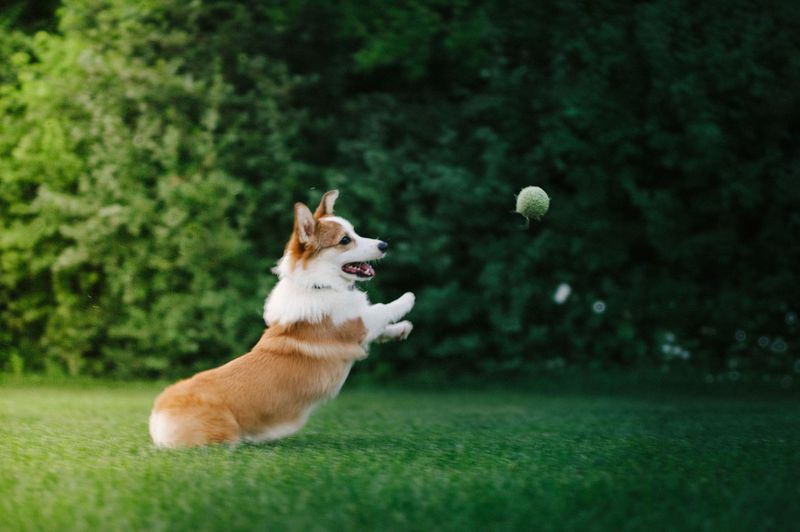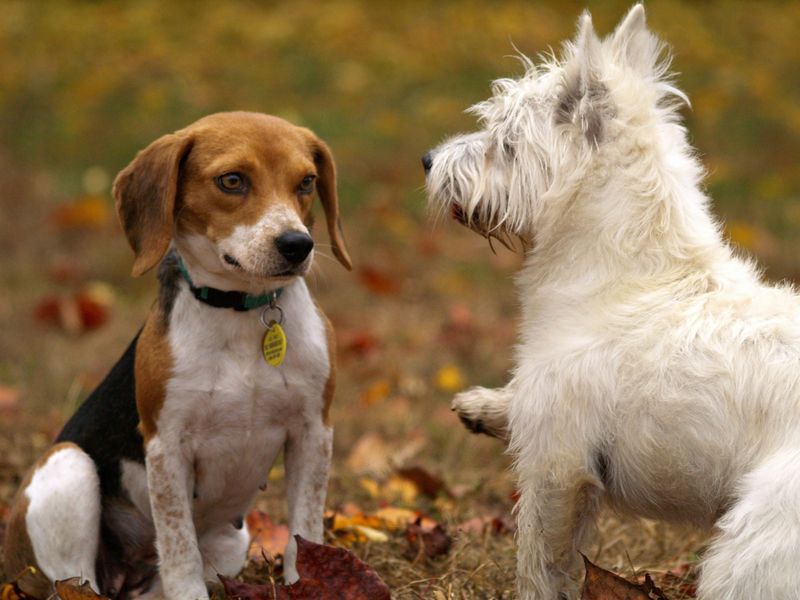10 Signs Your Dog Is Truly Happy (And 2 That Signal Sadness)

Dogs bring so much joy into our lives, and as a proud dog parent, there’s nothing more rewarding than seeing your furry friend happy and thriving.
Over the years, I’ve learned that dogs have their own unique ways of expressing joy, whether it’s a wagging tail, playful zoomies, or just that loving look in their eyes.
Understanding these signs not only deepens the bond you share but also helps ensure your pup’s well-being. I’ll share unmistakable signs that your dog is truly happy and content—because a happy dog makes for a happy home!
1. Wagging Tail

The wagging tail is perhaps the most well-known sign of a happy dog. When your furry friend’s tail is wagging freely, it’s usually a good indication that they are excited and content.
This form of communication is universal among dogs, though the style of wag can vary depending on the breed. A high, fast wag often signals excitement, while a gentle sway can mean relaxed happiness.
It’s important to observe the entire body language to distinguish between happy wags and those that indicate nervousness or aggression.
For instance, a loose, wiggly body accompanying a wagging tail generally means a dog is comfortable and happy. On the other hand, a stiff body with a wagging tail could mean something different.
Understanding these nuances can help you respond appropriately to your dog’s needs. Encourage your dog when they wag their tail during playtime or walks, reinforcing their happiness. Regularly engaging in activities they enjoy can promote more tail-wagging moments, ensuring they remain joyous and healthy.
2. Playfulness

Playfulness is a surefire sign of a happy dog. When your dog engages in playful behavior, such as fetching a ball or tugging on a toy, it’s a clear indication of their contentment. This playful energy can manifest at any age, though puppies and younger dogs tend to exhibit it more frequently.
Play is not only a sign of happiness but also an essential part of a dog’s mental and physical health. It provides an outlet for energy, helps maintain a healthy weight, and fosters social bonds.
Observing your dog’s play habits can give you insights into their well-being. A sudden lack of interest in play might signal something is amiss.
To ensure your dog remains happy, incorporate various games and toys into their routine. Activities such as hide and seek, agility courses, and interactive toys can keep their minds engaged and their spirits high.
Encouragement and participation in their playtime further strengthen the bond between you and your dog.
3. Relaxed Body Posture

A relaxed body posture is a clear indication of a dog’s happiness and comfort. When your dog lounges with a loose and relaxed body, it shows they feel safe and content in their environment.
This posture can vary from sprawling on their back with legs in the air to simply lying on their side with their head resting comfortably.
Observing your dog’s body language can provide valuable insights into their mood. A dog that frequently adopts a relaxed posture in your presence feels secure and trusts you.
This state of relaxation is often accompanied by soft eyes, a gentle tail wag, and even the occasional happy sigh or grunt.
Creating an environment where your dog feels comfortable and safe is crucial for their happiness. Ensure they have a cozy bed or space where they can unwind.
Additionally, maintaining a calm and stable home environment will contribute to your dog’s overall sense of well-being and happiness.
4. Healthy Appetite

A healthy appetite is a positive sign that your dog is happy and in good health. When your dog eats with enthusiasm, it shows they are satisfied and enjoying their meals. This behavior often indicates both physical well-being and emotional contentment.
It’s essential to monitor your dog’s eating habits, as changes can sometimes signal underlying health issues.
A sudden increase or decrease in appetite might warrant a visit to the vet. Additionally, providing a balanced and nutritious diet tailored to your dog’s age, size, and activity level is crucial in maintaining their happiness and health.
Offering variety in their diet by introducing new, healthy foods or treats can also keep mealtime exciting and enjoyable.
Observing how your dog reacts to different foods can help you understand their preferences and ensure they look forward to mealtime, further contributing to their overall happiness.
5. Bright Eyes

Bright, sparkling eyes are a telltale sign of a happy and healthy dog. When your dog’s eyes are clear and lively, it reflects their inner joy and wellness.
These bright eyes are often accompanied by an attentive and curious expression, showing they are engaged with their surroundings.
Eyes can convey a lot about a dog’s emotions. A dog that maintains eye contact with a relaxed gaze is often expressing trust and affection.
However, it’s important to be mindful of the context, as prolonged staring can sometimes be perceived as a challenge or threat in the canine world.
Regularly observing your dog’s eyes for any signs of discomfort or dullness is essential. Ensuring they receive proper eye care, including regular check-ups, can help maintain their eye health.
A dog with healthy, bright eyes is more likely to be active, playful, and happy, making eye care a crucial aspect of their overall well-being.
6. Sociability

A happy dog often exhibits sociability, eagerly interacting with people and other animals. This behavior is a strong indicator of their emotional well-being.
When your dog seeks out social interactions, it shows they enjoy the company of others and feel secure in their environment.
Social dogs typically greet new people and animals with curiosity and enthusiasm. They may wag their tails, sniff, or invite others to play.
This sociable nature can vary depending on the dog’s breed, age, and individual personality. Some dogs are naturally more reserved, so it’s important to consider these factors when assessing their happiness.
To nurture your dog’s sociability, provide regular opportunities for socialization through playdates, trips to the dog park, or training classes.
Encouraging positive interactions can help reinforce your dog’s confidence and happiness, ensuring they remain friendly and well-adjusted.
7. Soft Vocalizations

Soft vocalizations, such as gentle barks, whines, or grunts, are often signs of a content and happy dog. These sounds indicate that your dog is trying to communicate with you in a friendly and positive manner. When your dog greets you with a soft bark or whimper, it’s usually a sign of affection and excitement.
Understanding your dog’s vocal cues can enhance your communication with them, strengthening your bond.
Pay attention to the context in which these vocalizations occur, as they can differ based on the situation. For example, a soft whine while being petted might indicate pleasure, while the same sound during a vet visit might mean discomfort.
Encouraging communication by responding to soft vocalizations with positive reinforcement can help build trust and happiness. Use gentle words and petting to reassure your dog, making them feel heard and loved. This mutual understanding contributes to their overall sense of well-being.
8. Curiosity

Curiosity is a hallmark of a happy dog. When your dog shows interest in their surroundings, eagerly exploring new sights, smells, and sounds, it indicates their mental stimulation and enjoyment.
This inquisitive nature is often seen in dogs of all ages, though puppies are particularly known for their curiosity.
Encouraging your dog’s curiosity can lead to new adventures and a more enriched life. Providing opportunities for exploration, such as walks in different environments or introducing new toys and puzzles, can stimulate their minds and keep them engaged.
It’s important to balance curiosity with safety, ensuring your dog explores in a secure environment. By fostering their inquisitive nature, you can support their happiness and well-being, creating a joyful and fulfilling life for your furry companion.
9. Belly Exposure

A dog that willingly exposes its belly is often expressing trust and happiness. This vulnerable position indicates they feel safe and comfortable around you, showing their complete trust in you. Belly exposure is frequently seen during play or when relaxing, signaling contentment and affection.
When your dog rolls over to show their belly, it’s often an invitation for belly rubs, which many dogs enjoy. Providing gentle tummy rubs can further enhance the bond between you and your dog, reinforcing their sense of security and happiness.
Understanding when your dog is seeking affection through belly exposure and responding appropriately can strengthen your relationship.
By acknowledging and respecting their cues, you contribute to their overall happiness, creating a loving and trusting connection.
10. Good Sleep Patterns

Good sleep patterns are indicative of a happy and healthy dog. A dog that enjoys restful and uninterrupted sleep is likely content and at ease in their environment.
Sleep is essential for a dog’s physical and emotional well-being, allowing them to recharge and process their experiences.
Observe your dog’s sleeping habits to ensure they are getting enough rest. Most dogs need about 12-14 hours of sleep per day, though this can vary based on age, breed, and activity level. Ensuring your dog has a comfortable sleeping area can promote better sleep and overall happiness.
If you notice any changes in your dog’s sleep patterns, such as restlessness or insomnia, it may be a sign of stress or health issues.
Consulting a veterinarian can help address any concerns, ensuring your dog remains happy, healthy, and well-rested.
11. Withdrawn Behavior

If your dog starts showing a lack of interest in activities they used to enjoy, it can be a subtle sign they’re feeling down.
A once-playful pup might seem more reserved, spending more time alone or sleeping more than usual. This behavior often reflects a shift in their emotional state, signaling that something might be bothering them.
12. Changes In Appetite

A noticeable change in eating habits can also be a sign of sadness or discomfort. Some dogs may eat significantly less, while others might refuse their favorite treats altogether.
On the other hand, a sudden increase in eating could indicate stress or emotional distress. Keeping an eye on their appetite helps you understand how they’re feeling and when they might need extra care or attention.






